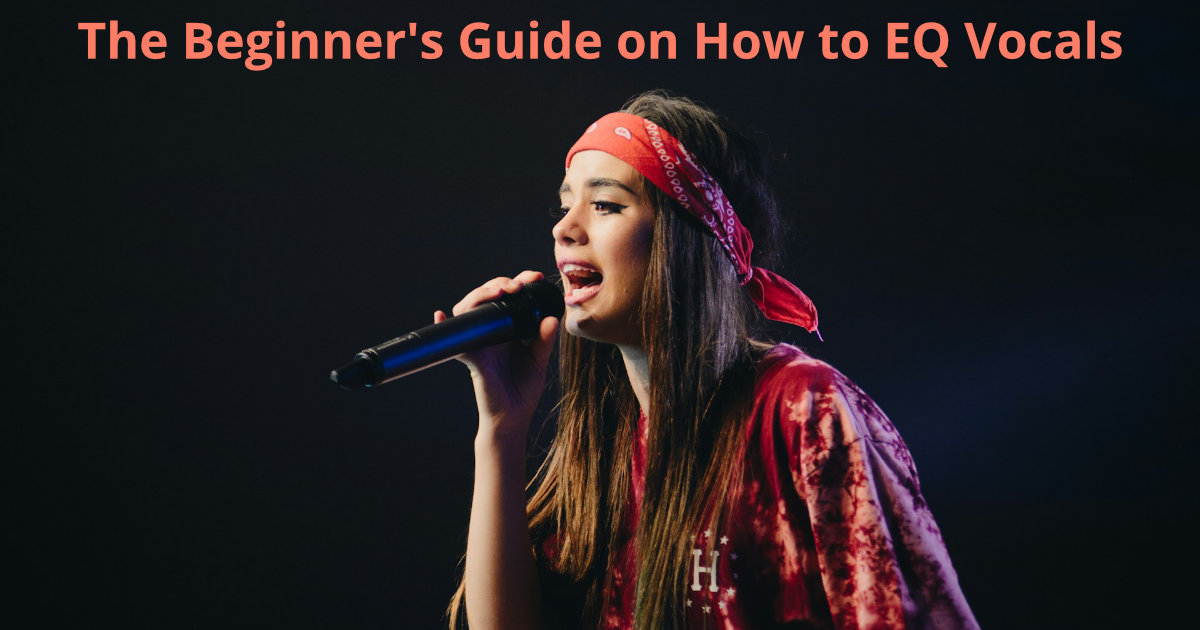Estimated reading time: 10 minutes
When you’re cutting a track, the vocals are your star. They’re the connection between the artist and the listener. But ever noticed how a raw vocal can stick out like a sore thumb in your mix? That’s where EQ, or equalization, comes into play. It’s like giving your vocals a custom-fit suit, tailored to shine in the mix. In this guide, we’re diving into how to EQ vocals, ensuring your vocal track sits just right, making your mix sound professional and polished.
Table of contents
- Understanding the Basics: What is EQ and its Role in Music Production
- Importance of EQ in Vocal Recording
- Comprehensive Guide: How to EQ Vocals
- Step-by-Step Guide: EQing Male and Female Vocals
- Techniques for EQing Background Vocals
- Using Filters in EQ: The Role of High-Pass Filter, Low-Pass Filter, and Shelf Filter
- Handling Problematic and Resonant Frequencies
- Understanding the Importance of Acoustic Treatment and Vocal Booth
- Applying EQ Techniques to Different Vocal Ranges and Bass Frequencies
- Advanced Tips for Achieving Stellar Vocal Sound
- Vocal EQ Techniques You Should Know – Video
- Conclusion: The Impact of EQ on the Human Voice in Music Production
- FAQ
Understanding the Basics: What is EQ and its Role in Music Production
EQ is the sculptor’s tool of the music world. Imagine chiseling away at the marble of sound to reveal the masterpiece beneath. It allows you to boost or cut specific frequency ranges in your vocal track, shaping the sound to fit perfectly in the frequency spectrum. EQ is critical, not just for carving out space for each instrument, but for enhancing the clarity and character of the human voice.
Importance of EQ in Vocal Recording
In vocal recording, EQ is like the best friend you didn’t know you needed. It helps clean up muddy sounds, tame harshness, and bring out the warmth and presence of the vocal sound. Without EQ, vocals can conflict with other elements in the mix, leading to a cluttered and amateur result. Applying EQ ensures that your vocal track cuts through the mix, delivering the emotional punch that the artist intended.
Comprehensive Guide: How to EQ Vocals
Ready to make your vocals pop? EQing vocals isn’t one-size-fits-all, but there are golden rules to follow. Your goal is balance – a vocal that’s clear and harmonious with the mix. You’ll need to listen critically, adjusting frequencies to complement the vocal range and the song’s style. It’s not just about boosting the good stuff; sometimes, cutting frequencies can make a world of difference.
Exploring Frequency Spectrum and its Relevance in EQ Vocals
The frequency spectrum is the playground for EQ. Vocals typically live in the mid-range, but there’s a whole world of harmonics and overtones in the highs, and sometimes in the lows. Understanding which frequencies correspond to which aspects of the vocal sound is key. The lows add body, the mids bring out the character, and the highs add clarity and airiness.
| Frequency Range | Description | Relevance in EQ for Vocals |
|---|---|---|
| Sub-bass | Frequencies below 60Hz, felt more than heard | Typically rolled off in vocal EQ to remove rumble |
| Bass | 60Hz – 250Hz | Adds body and warmth to vocals, but should be controlled to prevent boominess |
| Low mids | 250Hz – 500Hz | Can contribute to muddiness if not managed properly |
| Midrange | 500Hz – 2kHz | Contains the fundamental frequencies of most vocals, critical for shaping vocal character |
| Upper mids | 2kHz – 4kHz | Presence and intelligibility of vocals, often boosted for clarity |
| Presence | 4kHz – 6kHz | Adds brightness and projection to vocals |
| Brilliance | 6kHz – 16kHz | Airiness and sparkle in vocals, but can cause sibilance if not controlled |
Vocal Frequencies: Distinguishing Fundamental Frequencies from Unwanted Frequencies
Every voice has its unique set of fundamental frequencies – the core pitches. But along with these come the unwanted frequencies: hums, hisses, and harsh resonances that can muddy your vocal track. Learning to identify and mitigate these is crucial for a clean vocal sound. You’ll want to preserve the fundamentals while sweeping away the rest.
Looking to elevate your music production with pristine acapella vocals? Dive into our collection of acapella samples, where you’ll find a treasure trove of raw vocal tracks ready to inspire your next masterpiece. Whether you’re crafting EDM anthems or soulful ballads, our acapella vocals offer the perfect foundation to unleash your creativity. Explore the limitless possibilities and bring your tracks to life with the magic of acapella vocals. Discover the power of acapella samples today!

Step-by-Step Guide: EQing Male and Female Vocals
Male and female vocals differ in their frequency range. For male vocals, you might start by rolling off the very low end to remove rumble and add some presence in the upper mids. Female vocals may require a gentler touch in the lows and attention to sibilance in the highs. Each voice is unique, so trust your ears and adjust accordingly.
Techniques for EQing Background Vocals
Background vocals need to complement, not compete with, the lead. EQing them involves creating space so they support the lead without overwhelming it. Often, this means rolling off both the low end and some of the high end, letting the mid-range frequencies of the lead vocals stand out. Balance and blend are your objectives.
Using Filters in EQ: The Role of High-Pass Filter, Low-Pass Filter, and Shelf Filter
Filters are the EQ’s scalpel, allowing precise cuts. The high-pass filter is your go-to for eliminating low-end rumble, letting the vocal track breathe. The low-pass filter can help tame overly bright vocals. Shelf filters allow you to adjust a broad frequency range, either boosting or cutting, to tailor the vocal sound without drastic changes to the character.
| Filter Type | Description | Role in Vocal EQ |
|---|---|---|
| High-Pass Filter | Attenuates frequencies below a set point, allowing higher frequencies to pass through unaffected. Useful for removing low-end rumble and unwanted low-frequency noise. | Eliminates low-end rumble and unnecessary bass frequencies from vocal tracks. |
| Low-Pass Filter | Attenuates frequencies above a set point, allowing lower frequencies to pass through unaffected. Helpful for reducing harshness and controlling overly bright vocals. | Tames overly bright vocals and reduces sibilance by attenuating high-frequency content. |
| Shelf Filter | Adjusts a broad range of frequencies above or below a specified cutoff point, boosting or cutting them evenly. Commonly used to shape the overall tonal balance. | Allows broad adjustments to the tonal balance of vocals without affecting specific ranges. |
Handling Problematic and Resonant Frequencies
Sometimes, a vocal track has frequencies that just don’t play nice. Identifying and fixing these troublemakers is essential. Sweep the EQ to find and notch out problematic frequencies. Be surgical, though; too much cutting can lead to an unnatural sound. Resonant frequencies, on the other hand, can be tamed with targeted cuts or dynamic EQ for a more polished result.
| Issue | Description | Approach |
|---|---|---|
| Problematic Frequencies | Frequencies in the vocal track that stand out negatively, such as harsh resonances, nasal tones, or frequency build-ups. | Identify problematic frequencies using EQ sweeps or spectrum analyzers. Apply narrow cuts to attenuate or notch out these frequencies while preserving the natural vocal tone. |
| Resonant Frequencies | Frequencies that resonate excessively or cause unwanted emphasis, leading to an unnatural or boomy sound in the vocal track. | Target resonant frequencies using EQ sweeps or dynamic EQ. Apply precise cuts or dynamic processing to tame and control resonance, ensuring a more balanced and polished vocal sound. |
Understanding the Importance of Acoustic Treatment and Vocal Booth
Your EQ moves can only do so much if the recording space isn’t up to snuff. Acoustic treatment and a good vocal booth create a clean slate for recording, minimizing room reflections and unwanted noise. This means less corrective EQ later and a more natural-sounding vocal track. Always aim for the best source recording – it makes the EQ process far more effective.

Applying EQ Techniques to Different Vocal Ranges and Bass Frequencies
Vocal ranges vary, and so should your EQ approach. For higher ranges, you might focus on smoothing out the sibilance and adding warmth. For lower ranges, it’s about clarity without boominess. And don’t forget the bass frequencies – they should support, not overshadow the vocals. EQ can help achieve a harmonious balance between the vocal range and the bass.
| Vocal Range | Description | EQ Techniques |
|---|---|---|
| Higher Ranges | Frequencies typically above 1kHz | Focus on smoothing out sibilance, reducing harshness, and adding warmth through gentle boosts in midrange frequencies. |
| Lower Ranges | Frequencies typically below 1kHz | Emphasize clarity without boominess by controlling bass frequencies, removing mud, and enhancing presence in midrange. |
| Bass Frequencies | Frequencies below 250Hz | Ensure bass frequencies support but do not overshadow the vocals. Use high-pass filters to remove rumble and muddiness. |
Advanced Tips for Achieving Stellar Vocal Sound
Once you’ve got the basics down, it’s time to fine-tune. Use automation to adjust EQ settings for different parts of the song. Consider parallel EQ for added depth. And always A/B test your changes to ensure they’re truly enhancing the track. Remember, subtlety is often the key to advanced EQing – small tweaks can lead to significant improvements.
| Advanced Tips | Description |
|---|---|
| Utilize Automation | Automate EQ settings to adjust dynamically throughout the song, tailoring the vocal sound to different sections or intensities for greater impact. |
| Experiment with Parallel EQ | Apply parallel EQ processing by duplicating the vocal track, processing each version differently, and blending them together for enhanced depth and richness. |
| A/B Test Your Changes | Compare your EQ adjustments with the original vocal sound to ensure they genuinely enhance the track without detracting from its natural qualities. |
| Embrace Subtlety | Make subtle EQ tweaks rather than drastic changes to preserve the natural characteristics of the vocal while still achieving improvements in clarity and balance. |
| Consider Dynamic EQ | Use dynamic EQ to target specific frequency ranges only when they exceed a certain threshold, allowing for precise control over problematic frequencies. |
Vocal EQ Techniques You Should Know – Video
Conclusion: The Impact of EQ on the Human Voice in Music Production
The right EQ moves can elevate a vocal from good to great, giving it the power to resonate with listeners on a deeper level. It’s an art form in itself, blending technical skill with creative intuition. By understanding and applying these EQ techniques, you can ensure that the human voice in your productions always takes center stage, captivating and engaging your audience.
Looking for the best EQ plugins to get your vocals sounding stellar? Check out our top picks for the best EQ plugins on the market today!
Related Posts
- How Loud Should Vocals Be in a Mix? Finding the Perfect Balance
- How to Start Making Music? A Beginner’s Guide
- How to Remix a Song? A Simple Guide
- What Does a Recording Engineer Do? Behind the Soundboard
- What is a Vocal Run? Unleashing the Magic
- What is a Vocal Chain: Everything You Need to Know to Sound like a Pro
- Best DAW to Record Vocals – Discover the Ultimate DAW for Professional Vocal Recording
- What Is Gain in Audio? Understanding Gain in Simple Terms
- What is Audio Normalization? Breaking Down the Basics
- What is Treble in Music? Breaking it Down
- Mastering in Ableton: Elevate Your Music to Professional Quality
- How to Compress Vocals? A Step-by-Step Guide to Perfectly Compressed Vocals
FAQ
Absolutely! While a pro studio is ideal, you can still achieve great results with good headphones, some basic acoustic treatment, and a keen ear.
It depends. EQing before compression can help shape the sound going into the compressor, while EQing after can refine the compressed sound. Experiment to find what works best for your track.
Start with a spectrum analyzer to visualize the frequencies. Then, use your ears to make decisions. If something sounds off, sweep the EQ to find and address the problem areas.
Yes! Solo EQ focuses solely on the vocal sound, while EQing in a mix considers how the vocals interact with other elements. Always check your EQ adjustments in the context of the full mix.
Over-EQing. It’s tempting to make dramatic changes, but often, less is more. Aim for subtle adjustments that enhance rather than overpower the natural vocal quality.
